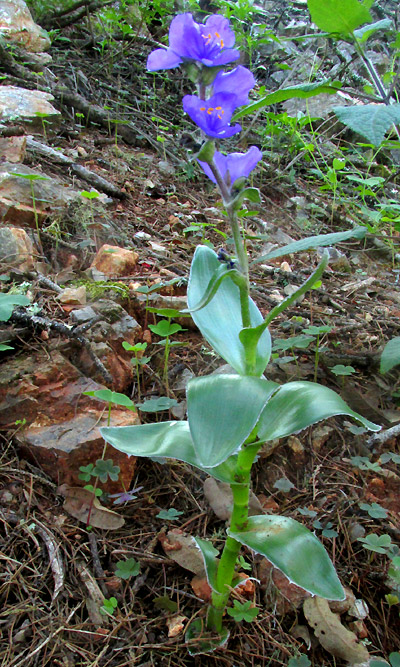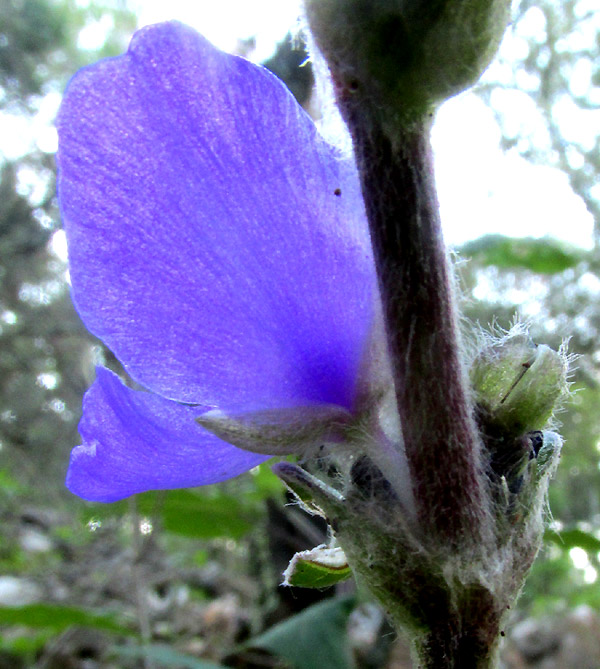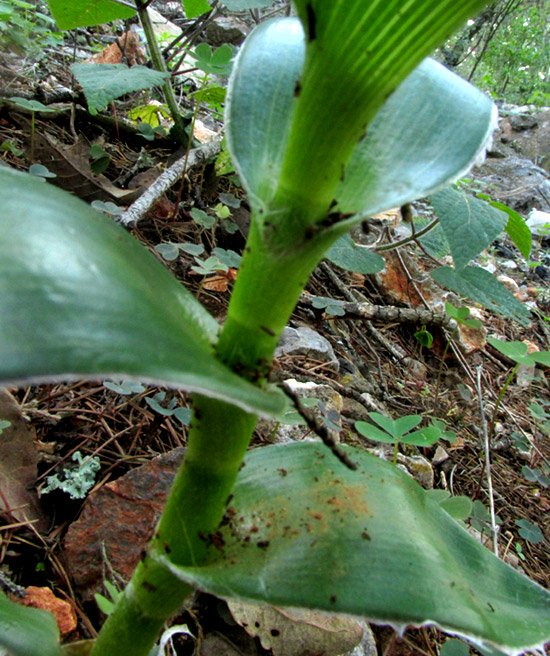Excerpts from Jim Conrad's
Naturalist Newsletter
Entry from field notes dated September 1, 2023, taken in Los Mármoles National Park in the Eastern Sierra Madre mountains, Hidalgo state, MÉXICO, along steeply climbing road heading eastward out of town of Trancas {on maps designated "Morelos (Trancas)"} toward Nicolás Flores; juniper/pine forest on limestone bedrock; elevation ~2,300m (~7,550ft); ~N20.80°, ~W99.25°
LEATHERLEAF SPIDERWORT
 On a steep slope in a shaded valley, in early morning I emerged from my tent to find the wildflower at the right standing composed and almost glowingly, like a smiling gnome, not three meters away. In the previous late afternoon while erecting the tent, I'd not noticed it, maybe because by day's end the blossoms had wilted and the light was different. At first glance, with its shiny leaves and bright flowers, I thought it might be an orchid, but a closer look at the blossoms told a different story:
On a steep slope in a shaded valley, in early morning I emerged from my tent to find the wildflower at the right standing composed and almost glowingly, like a smiling gnome, not three meters away. In the previous late afternoon while erecting the tent, I'd not noticed it, maybe because by day's end the blossoms had wilted and the light was different. At first glance, with its shiny leaves and bright flowers, I thought it might be an orchid, but a closer look at the blossoms told a different story:

The blossom's blueness is so radiant that it's hard to see that the corolla consists of three separate petals. Along with the conspicuous stamens with their hairy anther bases, this is a commonly occurring blossom type found in the Spiderwort Family, the Commelinaceae. However, to know which genus, we need to see what's below individual flower clusters:

Above, note that the flower cluster of one open flower and one still in its bud are subtended by short, leafy bracts. Two or so flowers in each cluster, and the blossoms displaying radial symmetry and six stamens, signifies the commonly occurring, species-rich genus Tradescantia, the true spiderworts after which the family was named.

At the right you see how our spiderwort's broad leaf bases wrapped around the unbranched stem.
Among Tradescantia species we've seen with similar flowers but dispaying other differences in body structure and growth form include the species subaspera, spathaceae and pallida. Note that the vegetative parts of our species beside the tent are exceptionally long hairy, or lanate.
Of the 85 or so recognized Tradescantia species worldwide, the 2021 work by José Luis Villaseñor others entitled "Riqueza y distribución de la flora vascular del estado de Hidalgo, México" lists eight documented species for our state of Hidalgo. Of these, if the blossoms are gathered into few-flowered clusters along a stem, with each cluster subtended by bracts which become smaller higher up the stem, the plants are densely long hairy, the stems develop few or no branches, and the stamens' filaments are all more or less the same height, you have TRADESCANTIA CRASSIFOLIA, sometimes in English known as Leatherleaf Spiderwort.
Because of the striking impression this plant made that morning, I felt sure it must be a rare and poorly documented species. However, Tradescantia crassifolia is distributed all the way from Mexico's northern border with Texas and New Mexico (not found in the US in recent years), southward through Mexico's uplands all the way into Honduras. The Flora del Bajío describes the species as the most abundant Tradescantia within that flora's area of upland central Mexico. The plat is described as growing in open areas including pastures, as well as various highland forest types, and scrubby zones; its flexibility of habitat preference accounts for its commonness.
The undated work by H.A. Castillo-Gómez and others entitled "Estudio Etnobotánico de las Comunidades Xi'oky del Matorral Submontano de La Palma, Tamasopo, S.L.P" found that in a traditional indigenous community in San Luis Potosí state in central Mexico, Tradescantia crassifolia was a source of food, called stelloam'. The 2013 study by Laura White-Olascoaga and others entitled "Flora Medicinal en San Nicolás, Municipio de Malinalco, Estado de México," found that in Mexico State in central Mexico Tradescantia crassifolia was a traditional herb used for treating hemorrhaging uteruses, menstrual and stomach pain, hangovers, and to reestablish one's intestinal flora.
In this area, Spanish names for our plant include hierba del ángel and hierba del pollo -- "angel plant" and "chicken plant." It seems that local people have noted both our plant's ethereal appearance under certain circumstances, and the way chickens like to peck at it.